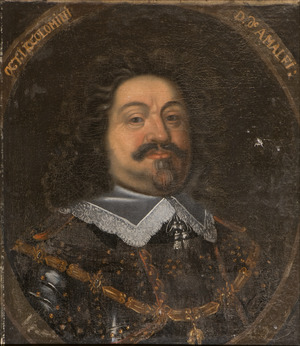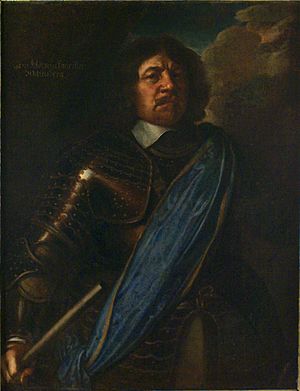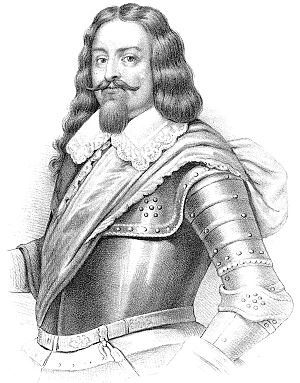Breitenfeld (1642) order of battle facts for kids
The Second Battle of Breitenfeld was a major engagement of the Thirty Years' War between the Imperial Army of the Holy Roman Empire under Archduke Leopold Wilhelm of Austria and Ottavio Piccolomini, supported by Saxon troops, and the Swedish Army under Lennart Torstensson. It was the last battle of the war featuring more than 20.000 soldiers on each side and one of the rare occasions where both combatants were attacking.
The Swedish Army had been besieging the nearby Saxon fortress Leipzig but relieved it in face of the Imperial advance. The imperials interpreted the Swedish movements as an unorganized retreat because the Swedes had trickled out their troops to obtain a more favourable terrain. The imperial war council under the Archduke overruled Piccolomini's objections against battling an almost even-matched opponent in open field and ordered an attack. The Swedes awaited them in battle formation at Breitenfeld, the place of Gustavus Adolphus' famous victory in 1631.
Both armies used a linear formation with two wings of cavalry around the infantry in the center. The infantry was divided in two subgroups by both armies because of the woods that intersected the imperial lines. An early rout of the Madlo Arquebusier and most of the Saxon regiments at the imperial left wing allowed the Swedes to gain the upper hand on this side of the battle. The imperial right wing achieved similar success against the Swedish left until Torstensson sent large parts of his victorious right around the woods and behind the imperial center to attack the imperial right from the rear. They ultimately drove the imperials from the field, only the Leibregiments supported by Alt- and Neu-Piccolomini, Mislik, Borneval and Luttke resisted long enough to cover the retreat of the right group of the imperial center. The left group however was encircled and forced to surrender by the victorious Swedes.
Contents
Imperial-Saxon army
There are essentially two different orders of battle for the Imperial-Saxon army. The one cited by William Guthrie mostly uses the information from the Theatrum Europaeum. According to Otto Rudert, this order of battle was the intended one but was changed shortly prior to the battle. Rudert and Arndt Preil instead use the Callenbergische Battaglia from the battle report of Colonel Kurt Reinecke von Callenberg. The Battaglia is meant to indicate the actual order of troops in battle and is used in this list.
Overall commanders were Archduke Leopold Wilhelm of Austria and Field-Marshal Ottavio Piccolomini. Unless otherwise noted, all units are German.
Left
Generalfeldwachtmeister Hans Christoph von Puchheim, 31 squadrons
First Echelon (Colonel Nicola Montard de Noyrel)
- Pompeij Cuirassier – Colonel Thomas Pompeji
- Madlo Arquebusier – Colonel Hans Georg Madlo
- Luigi Gonzaga Cuirassier – Major Khauts
- Vorhauer Cuirassier – Colonel Hans Vorhauer
- Wintz Cuirassier – Colonel Christoph von Wintz
- Jung-Heister Cuirassier – Colonel Arnold von Heister
- Alt-Heister Cuirassier – Lieutenant Colonel Andreas Stahl
- Nicola Cuirassier – Lieutenant Colonel Dominik Cadé
- Puchheim Cuirassier – Lieutenant Colonel Candido
Second Echelon (Colonel Schleinitz)
- Burksdorf Cuirassier – Colonel Conrad Burksdorf
- Warlowsky Arquebusier – Colonel Peter Warlowsky
- Krafft zu Lammerstorf Cuirassier – Colonel Heinrich Krafft zu Lammerstorf
- Callenberg Saxon Cuirassier – Colonel Kurt Reinecke von Callenberg
- Gall à Bourck Dragoons – Lieutenant Colonel Olivier Stephanson
- Knoche Saxon Cuirassier – Colonel von Knoche
- Gallas Dragoons – Lieutenant Colonel Johann Ablmont
- Schleinitz Saxon Cuirassier – Colonel von Schleinitz
Flankers
- 8 squadrons of Croats and Cossacks
Center
Feldzeugmeister Ernst Roland von Suys, 11 brigades, 8 squadrons, 46 guns
Left Group (Feldzeugmeister Johann Barwitz von Fernemont and Generalfeldwachtmeister Anton von Weveld)
- Enkevort Infantry – Lieutenant Colonel Michael Thomb
- Weveld Infantry – Lieutenant Colonel Simon Schrenk genannt Notzing
- Caretto di Grana Infantry – Lieutenant Colonel Paolo Pestaluzzi
- Sax-Lauenburg Infantry – Lieutenant Colonel Rohrscheid
- Moncada Infantry – Colonel Matteo Marchese di Moncada y Cardona
Right Group (Generalfeldwachtmeister Camillo Gonzaga)
- Suys Infantry (Walloon) – Lieutenant Colonel Eusebius von Crivelli
- Annibale Gonzaga Infantry – Lieutenant Colonel Valentin Hauser
- Ranfft Infantry – Colonel Johann Christoph Ranfft von Wiesenthal
- Archduke Leib Infantry – Lieutenant Colonel Gustav
- Fernemont Infantry – Lieutenant Colonel Nouskovsky
- Wachenheim Infantry – Colonel Otto Ludwig von Wachenheim
Reserve (Feldzeugmeister Suys)
- Archduke Leib – Colonel Sforza Marchese di Pallavicini
- Piccolomini Leib – Lieutenant Colonel Ghiselieri
- Grodetzky Arquebusier – Colonel Georg Dietrich Grodetzky von Grodetz
- Gissenburg Cuirassier – Colonel Tobias von Gissenburg
- Desfours Cuirassier (Spanish-German) – Colonel Johann von Desfours
- Paconchay Dragoons – Colonel Martin de Paconchay
Right
Feldzeugmeister Annibale Gonzaga, 32 squadrons
First Echelon (Lieutenant Field Marshall Albert Gaston Spinola von Bruay)
- Mislik Cuirassier – Colonel Johann Sigmund von Mislik
- Alt-Piccolomini Cuirassier – Lieutenant Colonel Georg von Crespu
- Bruay Cuirassier – Lieutenant Colonel Claus von Paumgarten
- Jung Cuirassier – Colonel Gottfried von Jung
- Montecuccoli Cuirassier – Lieutenant Colonel Claudius Franz von Lannoy
- Sperreuter Cuirassier – Lieutenant Colonel Johann Walter
- Neu-Piccolomini Cuirassier– Colonel Paul Béchamp
- La Corona Dragoons – Colonel Johann de la Corona
Second Echelon (Generalfeldwachtmeister Jacob Borneval d’Arlin)
- Spiegel Cuirassier – Lieutenant Colonel Lützelburg
- Lüttke Cuirassier – Colonel Moriz von der Lüttke
- Wolframsdorf Cuirassier – Colonel Rudolph Georg von Wolframsdorf
- Kapaun Cuirassier – Colonel Albrecht Weikhard Kapaun von Swoykow
- Hanau Saxon Cuirassier – Generalfeldwachtmeister Augustin von Hanau
- Borneval Cuirassier – Lieutenant Colonel Dohna
- Munster Arquebusier – Colonel Christian von Münster
Flankers
- 8 squadrons of Croats and Cossacks
Swedish army
Field Marshal Lennart Torstensson
Right
Major general Arvid Wittenberg, major general Torsten Stålhandske, 24 squadrons, 13 detachments, 13 guns
First Echelon (Major general Wittenberg)
- Torstensson Leib Cuirassier
- Hesse Cuirassier
- Duval Cuirassier – Colonel Tobias Macdougall
- Hoking Cuirassier
- Kinsky Cuirassier
- Detachments: each regiment 40 musketeers and one light gun
Second Echelon (Major general Stålhandske)
- Derfflinger Cuirassier
- Wittkopf Cuirassier – Colonel Johann von Wittkopf
- Helm Wrangel
- Polish Cuirassier
Center
Riksfälttygmästare Johan Lilliehöök, 11 brigades, 3 squadrons, 18 heavy and 23 light guns
Left Group (Major general Carl Gustaf Wrangel)
First Echelon
- C. G. Wrangel Infantry (Swedish-German)
- Mortaigne Infantry
Second Echelon
- Axel Lillie Infantry (Swedish-German) – Major general Axel Lillie
- Schlieben Infantry – Colonel Hans Heinrich von Schlieben
Right Group (Major general Kaspar Kornelius Mortaigne de Potelles)
First Echelon
- Lilliehöök Infantry
- Banér Infantry – Colonel Gustav Banér
Second Echelon
- Pfuhl Infantry
- Jeschwitski Infantry
Third Echelon Reserve
- Maul Infantry – Colonel William Maul
- Plettenberg Infantry
- Old Blue Infantry (Veteran)
- 3 cavalry squadrons from different regiments
Left
Major general Erik Slang, major general Hans Christoff von Königsmarck, 24 squadrons, 16 detachments, 16 guns
First Echelon (Major general Slang)
- Stålhandske Cuirassier (Finn-German)
- Wittenberg Cuirassier (Finn-German)
- Cratzenstein Cuirassier
- Douglas Cuirassier – Colonel Robert Douglas
- Billinghausen Cuirassier
- Schulmann Cuirassier
- Pfuhl Cuirassier
- Mitzlaff Cuirassier
- Detachments: each regiment 40 musketeers and one light gun
Second Echelon (Major general Königsmarck)
- Seckendorf Cuirassier
- Tideman Cuirassier
- Lilliehöök Cuirassier
Sources






